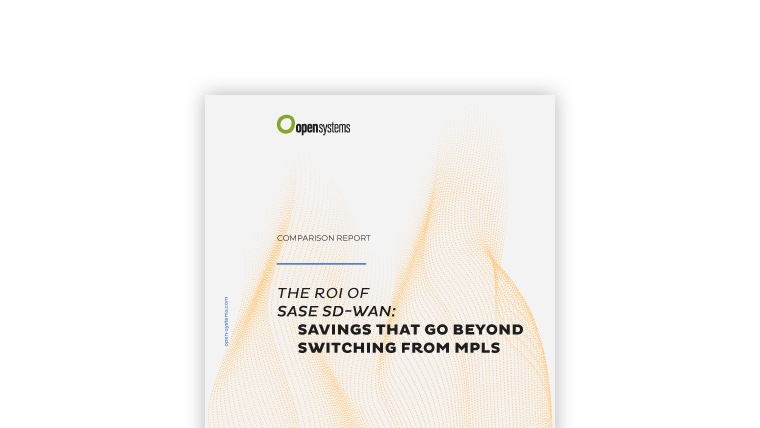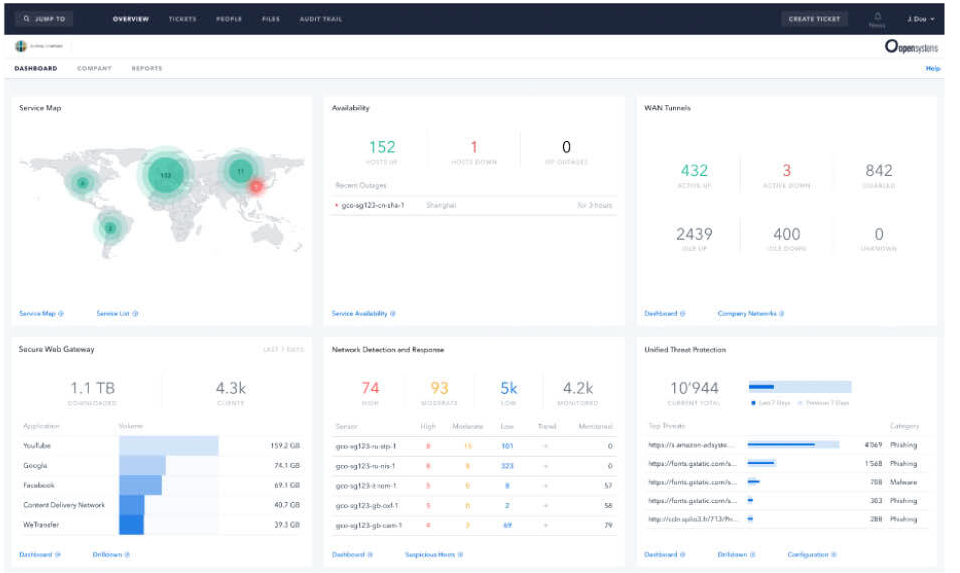KONTROLLE UND VERWALTUNG DER NETZWERKBANDBREITE
Der Netzverkehr nimmt zu und ist immer schwieriger vorherzusagen. Der Erwerb von Bandbreite, sei es MPLS-WAN oder Breitband, erfordert in der Regel die Bindung an Verträge, von denen die meisten langfristig angelegt sind. Es ist schwierig, Ausgaben für die Bandbreite zu rechtfertigen, ohne vorher sicherzustellen, dass die Netzwerke optimiert sind. IT-Fachleute sind proaktiv und können mithilfe von Netzwerk-Bandbreitenanalysatoren feststellen, wie gut ihre Netzwerke funktionieren. Anhand dieser Daten kann eine Ausgangsbasis für den Optimierungsprozess geschaffen werden, und es kann gemessen werden, wie gut die Tools, Verfahren und Techniken funktionieren.
Ein 3-Schritt-Ansatz zur Implementierung von
Bandbreitenüberwachung und -steuerung
- Cloud-Bandbreitenmonitore
- WAN-Bandbreitenmonitore
- Internet-Bandbreitenmonitore
- Verschiedene Anwendungsleistungsmonitore
- Unerlaubter oder böswilliger Datenverkehr
- Veraltete Hardware und Software
- Schlechte Bandbreitenplanung
- Schwierige Vorhersage von Spitzenverkehrszeiten
- Fehler in der Netzwerkkonfiguration
- Ungelöste Netzwerkengpässe
- Investition in Optimierungstools zur Ermittlung und Beseitigung von Engpässen
- Neukonfigurieren, Aktualisieren oder Ersetzen von Netzwerkausrüstung und Software, z. B.
- Anschaffung von Routern mit Bandbreitenkontrolle
- Software und/oder Hardware zur Bandbreitenkontrolle im Netzwerk
- Software und/oder Hardware zur Kontrolle der Internet-Bandbreite
- Schulung der Benutzer über die richtige Nutzung des Netzwerks und Techniken zur Reduzierung des Datenverkehrs
- Bereitstellung eines separaten Netzwerks für Gäste oder weniger leistungsempfindliche Benutzergruppen, Abteilungen oder Standorte
- Überprüfung von Cybersicherheitsmaßnahmen, die zu Latenzzeiten führen können
- Stärkere Komprimierung von Daten zur Verringerung der Netzwerklast
Schritt 1
Verwenden oder beschaffen Sie Netzwerk-Bandbreiten-Analysatoren, um Ihre Netzwerkleistung zu messen und Basiswerte zu ermitteln. Je nach Ihrer Netzwerkarchitektur benötigen Sie möglicherweise unterschiedliche Tools.
Messung des Durchsatzes – Erfassen Sie die Datenmenge, die zu einem bestimmten Zeitpunkt von einer Quelle zu einem Ziel übertragen wird. Paketverluste, erneute Sendeanforderungen, Latenzzeiten oder Jitter (Daten, die nicht strömen) beeinträchtigen die Leistung und sind Indikatoren für Durchsatzprobleme. Ursachen können sein:
Map Bandwidth – Erfassen Sie den theoretischen maximalen Durchsatz eines Netzwerks oder einer Verbindung. Sie wird daran gemessen, wie viele Daten in einem bestimmten Zeitraum übertragen werden können, und wird in Bits, Megabits oder Gigabits pro Sekunde angegeben. Um es mit einem Auto zu vergleichen: Die einzige Möglichkeit, die Bandbreite zu erhöhen, besteht darin, die Anzahl der Fahrspuren zu erhöhen oder schnellere Fahrspuren zu erhalten. Mit anderen Worten: Die Bandbreite ist endlich, es sei denn, Sie kaufen zusätzliche Verbindungen.
Schritt 2
Führen Sie Kontrollen für das Datenverkehrsmanagement ein und implementieren Sie Richtlinien für die Dienstqualität. IT-Fachleute können in Netzwerk-Tools zur Konfiguration und Überwachung der Servicequalität investieren. Damit wird sichergestellt, dass wichtige Anwendungen wie OLTP, VoIP, Videokonferenzen und Cloud-Anwendungen Priorität erhalten. Der IT-Experte muss festlegen, welche Anwendungen, Benutzer oder Standorte weniger wichtig sind und eine langsamere Leistung tolerieren können.
Schritt 3
Die letzte Phase der Optimierung umfasst proaktive Schritte wie:
Wenn alle oder einige dieser Maßnahmen das Leistungsproblem nicht vollständig lösen, haben IT-Experten möglicherweise keine andere Wahl, als in zusätzliche Bandbreite zu investieren.
Verwenden oder beschaffen Sie Netzwerk-Bandbreiten-Analysatoren, um Ihre Netzwerkleistung zu messen und Basiswerte zu ermitteln. Je nach Ihrer Netzwerkarchitektur benötigen Sie möglicherweise unterschiedliche Tools.
- Cloud-Bandbreitenmonitore
- WAN-Bandbreitenmonitore
- Internet-Bandbreitenmonitore
- Verschiedene Anwendungsleistungsmonitore
Messung des Durchsatzes – Erfassen Sie die Datenmenge, die zu einem bestimmten Zeitpunkt von einer Quelle zu einem Ziel übertragen wird. Paketverluste, erneute Sendeanforderungen, Latenzzeiten oder Jitter (Daten, die nicht strömen) beeinträchtigen die Leistung und sind Indikatoren für Durchsatzprobleme. Ursachen können sein:
- Unerlaubter oder böswilliger Datenverkehr
- Veraltete Hardware und Software
- Schlechte Bandbreitenplanung
- Schwierige Vorhersage von Spitzenverkehrszeiten
- Fehler in der Netzwerkkonfiguration
- Ungelöste Netzwerkengpässe
Map Bandwidth – Erfassen Sie den theoretischen maximalen Durchsatz eines Netzwerks oder einer Verbindung. Sie wird daran gemessen, wie viele Daten in einem bestimmten Zeitraum übertragen werden können, und wird in Bits, Megabits oder Gigabits pro Sekunde angegeben. Um es mit einem Auto zu vergleichen: Die einzige Möglichkeit, die Bandbreite zu erhöhen, besteht darin, die Anzahl der Fahrspuren zu erhöhen oder schnellere Fahrspuren zu erhalten. Mit anderen Worten: Die Bandbreite ist endlich, es sei denn, Sie kaufen zusätzliche Verbindungen.
Führen Sie Kontrollen für das Datenverkehrsmanagement ein und implementieren Sie Richtlinien für die Dienstqualität. IT-Fachleute können in Netzwerk-Tools zur Konfiguration und Überwachung der Servicequalität investieren. Damit wird sichergestellt, dass wichtige Anwendungen wie OLTP, VoIP, Videokonferenzen und Cloud-Anwendungen Priorität erhalten. Der IT-Experte muss festlegen, welche Anwendungen, Benutzer oder Standorte weniger wichtig sind und eine langsamere Leistung tolerieren können.
Die letzte Phase der Optimierung umfasst proaktive Schritte wie:
- Investition in Optimierungstools zur Ermittlung und Beseitigung von Engpässen
- Neukonfigurieren, Aktualisieren oder Ersetzen von Netzwerkausrüstung und Software, z. B.
- Anschaffung von Routern mit Bandbreitenkontrolle
- Software und/oder Hardware zur Bandbreitenkontrolle im Netzwerk
- Software und/oder Hardware zur Kontrolle der Internet-Bandbreite
- Schulung der Benutzer über die richtige Nutzung des Netzwerks und Techniken zur Reduzierung des Datenverkehrs
- Bereitstellung eines separaten Netzwerks für Gäste oder weniger leistungsempfindliche Benutzergruppen, Abteilungen oder Standorte
- Überprüfung von Cybersicherheitsmaßnahmen, die zu Latenzzeiten führen können
- Stärkere Komprimierung von Daten zur Verringerung der Netzwerklast
Wenn alle oder einige dieser Maßnahmen das Leistungsproblem nicht vollständig lösen, haben IT-Experten möglicherweise keine andere Wahl, als in zusätzliche Bandbreite zu investieren.
Laden Sie unser eBook herunter. Dieser neue Ansatz für die Vernetzung umfasst eine Reihe von vollständig integrierten, über die Cloud verwalteten Security-Services, die vor Ort oder in der Cloud mit zentral verwalteter Sicherheit bereitgestellt werden. Erfahren Sie, wie Sie:
- Verringerung der Komplexität und des betrieblichen Aufwands
- Benutzerfreundlichkeit / Transparenz für Anwender
- Mehr Sicherheit durch einen Zero-Trust-Netzwerkzugriff

Open Systems bietet eine einheitliche Sicht auf das gesamte Netz, einschließlich der Verkehrslasten und -muster für verschiedene Anwendungen. Die eingebettete Open Systems-Technologie analysiert und identifiziert, welche Art von Datenverkehr durch das Netz fließt.
- Sie klassifiziert den Verkehr und ordnet ihn verschiedenen Anwendungstypen zu.
- Sie kann auch so konfiguriert werden, dass sie spezielle Kundenanwendungen identifiziert, die ein hohes Maß an Leistung und Prioritäts-Routing erfordern.
- Die Netzwerkleistung wird für verschiedene Anwendungen kontinuierlich überwacht, um sicherzustellen, dass die QoS-Anforderungen erfüllt werden.

Lassen Sie die Komplexität
hinter sich
Sie möchten auch von der Open Systems SASE Experience profitieren? Unsere Experten helfen Ihnen gern weiter.
Kontakt



